2. Perceived Sharpness
This is the #1 claimed reason for the new generation of 50s like the Zeiss and the Sigma: high perceived sharpness even wide open. Whoever thinks that sharpness is for pixel peepers and people who hang out in forums discussing sharpness rather than actually shooting pictures: You’re right. But it’s also for people who actually shoot pictures. There’s a great quote by Mark Crislip aka PitchBlack who sums it up perfectly.
Still Life Shot: Detail Comparison
Ok, so here’s a still life motive that I was shooting and that I modified a bit for this test. Delicious hot pasta from ½” audio tape tossed with crunchy stereo jacks:
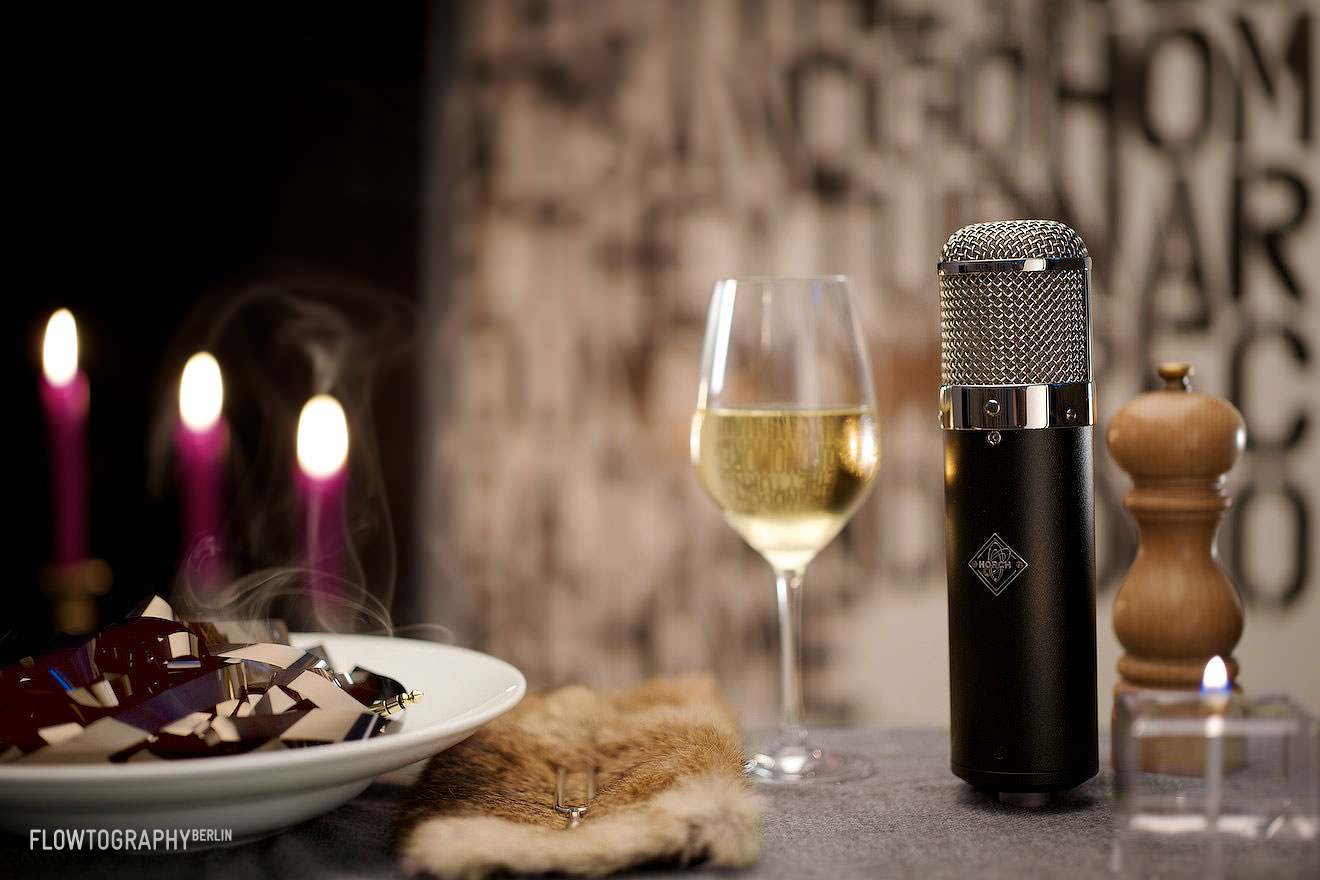
This was shot wide open with all lenses. For the 58 mm and 55 mm lenses, the camera was slightly pulled back to compensate for the focal length increase. The focus was set on logo of the Horch studio microphone on the right (see last paragraph of this section for details). The whole scene is lit by three lights plus the candles: A large soft box on a boom from above, a 15°-gridded highlight from the back right on the glass and a medium striplight behind a diffusor panel (for grading) on camera right. Yes, there’s lots of room for improvement, but this isn’t about the scene itself.
Let’s just look at a crop so we can compare perceived sharpness. This is really unbelievable. Check it out, these are 100% crops (as opposed to all the other images on this site, they’re not in high-dpi, so people with “retina” displays will find it a bit blurry).
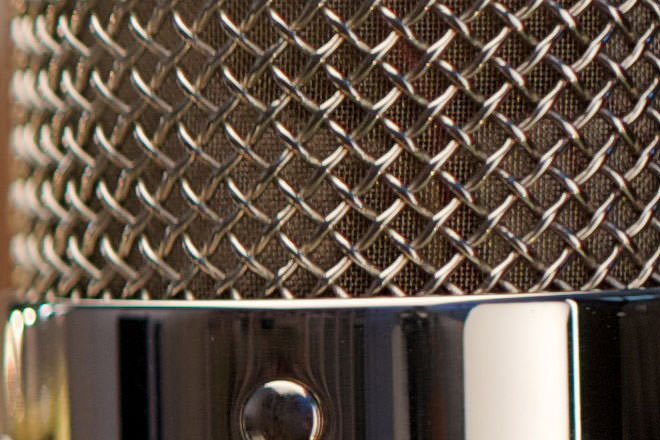


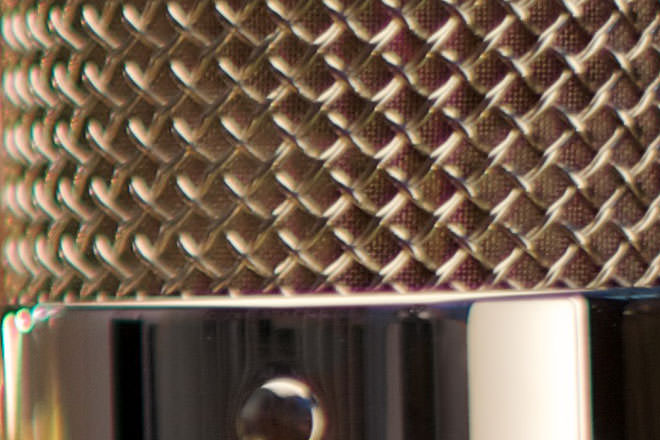




- As you can see, there’s just an extremely slight advantage of the Zeiss over the Sigma, but it’s hardly noticable. (Note that the focus plane is something like a mm further away with the Sigma image.) It’s absolutely breathtaking what level of detail these lenses both produce – wide open! Keep in mind that the images are on a D800, it must be even better on a D800E or D810.
- Just to give you an idea what league we’re talking about here, click next for a comparison of the Sigma and the horrible Nikkor 58/1.4G.
- Just because comparing the worst with the best is a little unfair, the next one shows the Nikkor 58 vs. an average lens, the 50/1.4G. I guess you get the idea now.
- Then, you can see a comparison of the two Nikkor 50s. They are not really that much different from each other, except for the color fringing (quite visible with the 1.4, not so with the 1.8).
- The next comparison is the Sigma with each of the 50 mm NIkkors.
- Finally, you get a comparison of the Zeiss with each of the Nikkor 50s.
Do these differences matter? Sometimes. Check out this separate article if you want to see how they do.
Addendum: Because some people asked how the focusing was done, I’ll tell you. As said, I used the center of the logo on the mic as a focusing point. With each lens, I took four shots. They were focused 1. with AF in Live View (this uses contrast detection), 2. manually after focusing to infinity, 3. & 4. repeat one and two. With the manual-focus Zeiss, I took four shots focused manually in Live View, focusing to infinity in between. I then compared the results in 100% view in post, and took the “best” shot, which was the first one in all cases – the Live View focusing did a good job. In the above crops you can see that the focus plane nevertheless isn’t precisely the same, but varies by a millimeter. However, as the selected crop intentionally contains a curved surface with a layered structure, you’ll be able to easily locate the in-focus structure in every shot.
You may interpret the failure to focus 100% accurately in two ways: a) This should not happen in a test! Correct. Well guess what: As you can imagine, I tried my very best, because, as you correctly noticed – this is a test. So if you consider the mm of focus point variation an issue, then the other interpretation is for you: b) Even if you try your best, use a heavy studio tripod, Live View, a still life scene and good light, this millimeter is what you can achieve in practice. At least in case you’re a photographer and not a test lab. So you may take this as an additional result.
Focus Test Chart Comparison
Yeah well, test charts. One quote I like from Ken Rockwell is: “…if you are shooting test charts, a flatbed scanner is still far better than a D800.” And I’d add that if you’re shooting brick walls, the thing you need to worry about most is your taste, not image quality. Anyways:
 I always use the Focus Test Chart by Tim Jackson to fine-tune the AF for my lenses before I first use them. The thing is, you can see quite a lot of your lens qualities from that simple chart, e.g. sharpness and contrast, longitudinal CA, focus shift. With this chart, the camera is pointed at a 45° angle to the chart, producing an image like the one on the right. The frame marks the crop area from which you see the images from the respective lens.
I always use the Focus Test Chart by Tim Jackson to fine-tune the AF for my lenses before I first use them. The thing is, you can see quite a lot of your lens qualities from that simple chart, e.g. sharpness and contrast, longitudinal CA, focus shift. With this chart, the camera is pointed at a 45° angle to the chart, producing an image like the one on the right. The frame marks the crop area from which you see the images from the respective lens.
Keep in mind that the “results” that you can see concern specifically the marked area of the image frame, i.e. off-center. Since the focus point of a good image is rarely in the exact middle, I don’t care much about this exact center, off-center like the marked area is actually much more relevant in my photography. (To get an idea of how sharpness varies across the image frame, you can check out the field maps on DxOmark: Choose a lens, and go to Measurements -> Sharpness -> Field map.)
Click through this gallery (100% crops @ high-dpi), a summary of which is provided below:
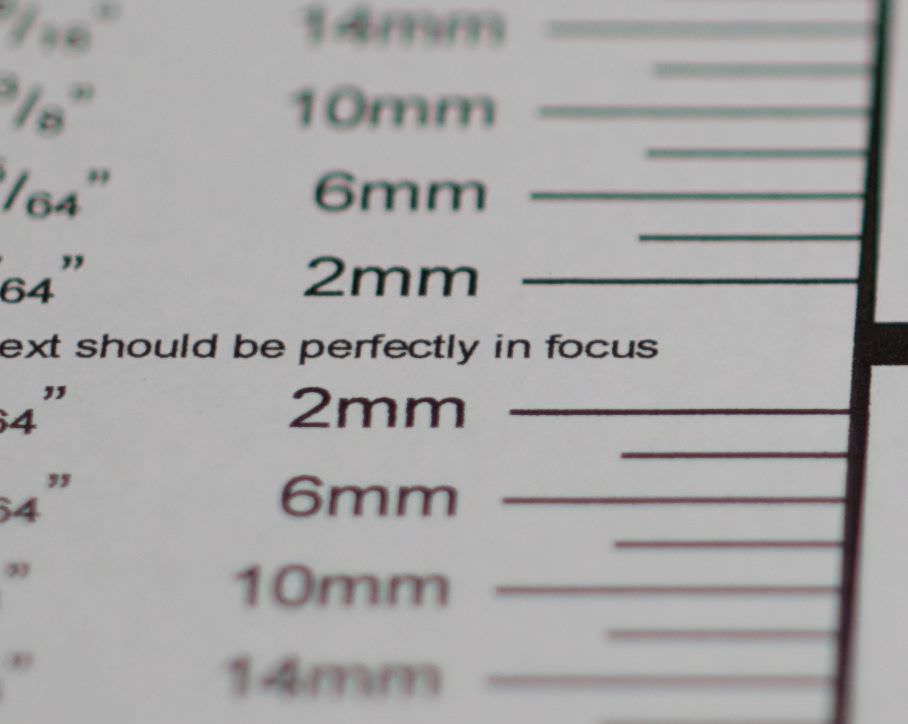


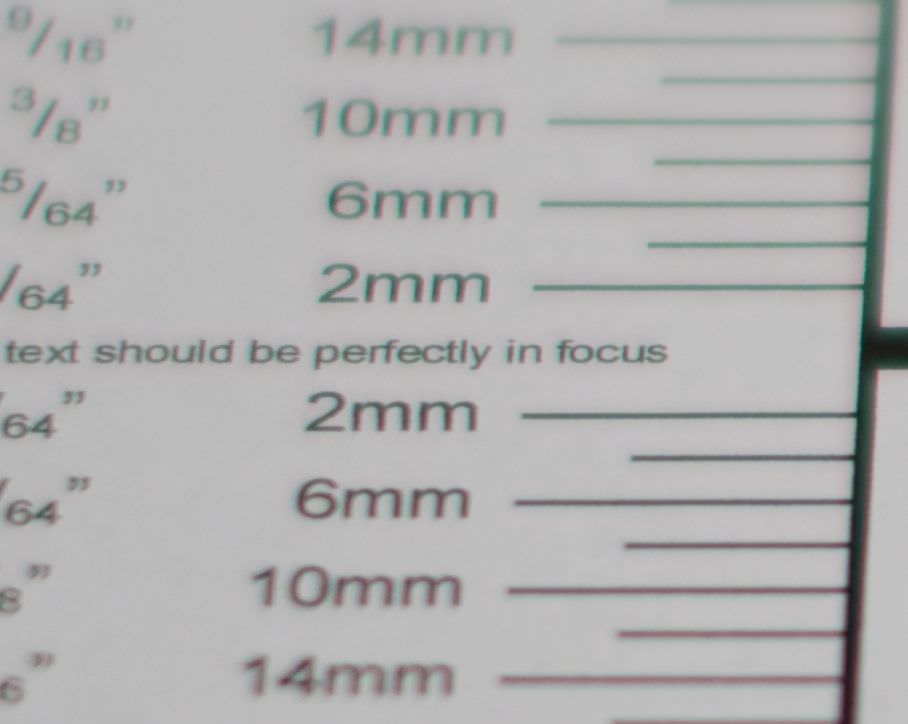
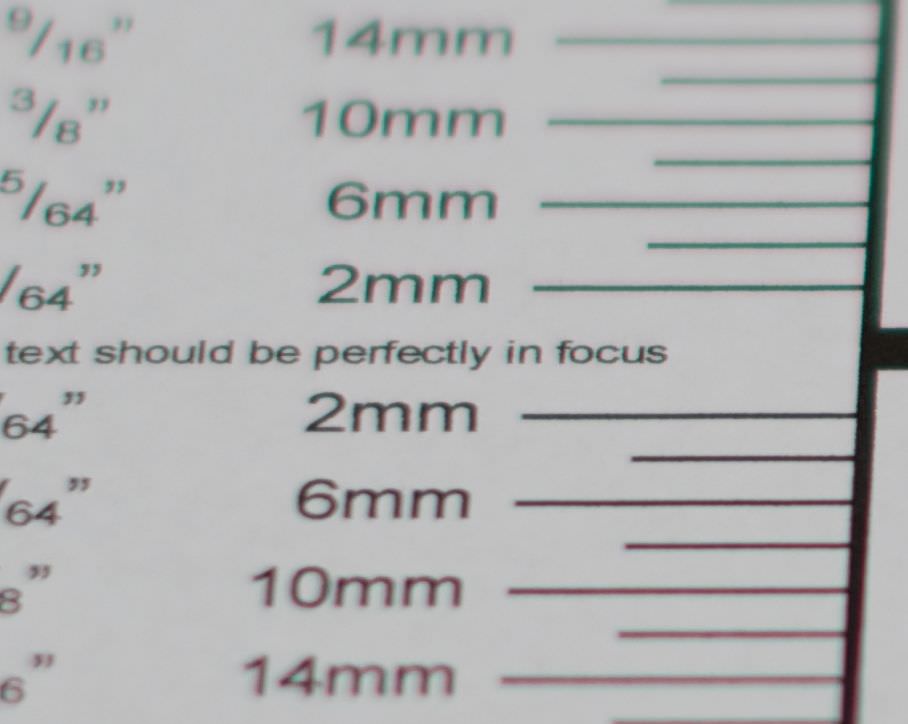


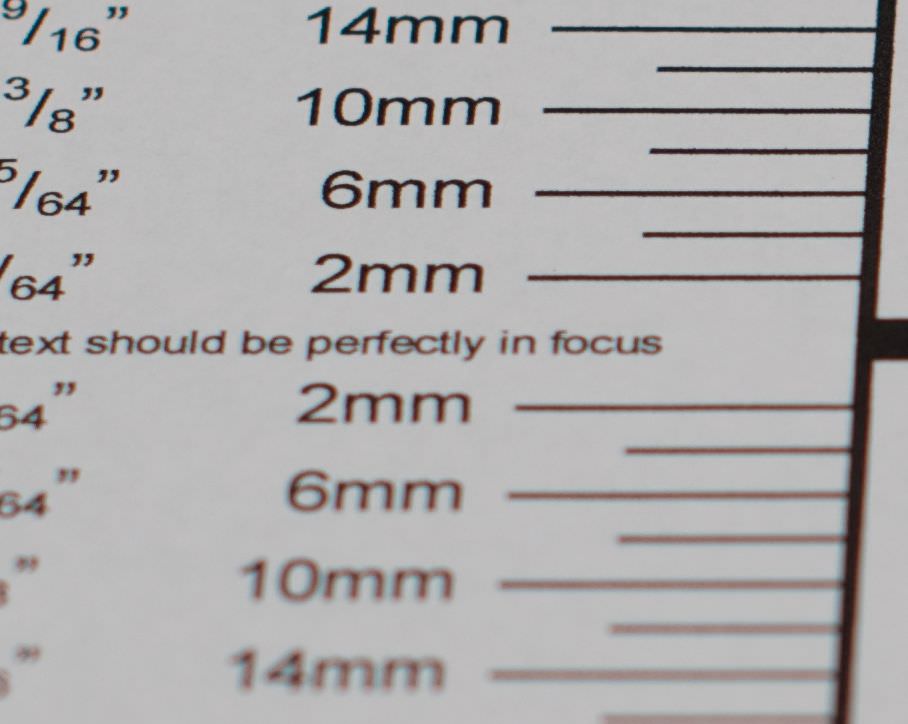
- The Zeiss is tack-sharp wide open, has very moderate spectrochromatism, and absolutely no focus shift.
- The Sigma is pretty much the same in this respect, only that there is noticable focus shift (which is normal for many lenses, unfortunately). Too bad, for a lens of this sharpness class, you might think. Well, the thing is, in practice, you won’t notice too much of this. Maybe this is something for a separate article.
- The 58mm Nikkor… as I said in the beginning: It’s a joke. It’s worse than the 50/1.4G. Useable results start at f/2.8. In the above examples you can see the heaps of CA, too. The only good thing about this lens is that there is no focus shift at all…
- …which again the Nikkor 50/1.4G has quite a lot of, the highest amount of all lenses. In the comparison slider you can see how the focus shifts backwards as the lens is stopped down. If you get a good copy (there seems to be considerable sample variation with these), it is as sharp as the 1.8G, with two third stops advantage. At f/1.4 it’s as sharp as the 1.8 at f/1.8, and so on. This goes for the off-center. In the center, they’re the same at the same aperture. Again, keep in mind that this varies with the quality of the 1.4G copy. What doesn’t vary:
- (Longitudinal) Chromatic aberration is substantially worse with the 1.4 than the 1.8. The 1.4G is infamous for this, too. It’s the main reason why I and many people I know got the 1.8G instead.
- Also, the Nikkor 50/1.8G has a lot less focus shift.
Before I go ahead and compare all the thousands of combinations, you can download the whole set (crops from all five lenses at f/1.4 through f/5.6) and compare yourself.
Go back to page 1: Introduction
Go to next page 3: Bokeh quality
Proceed to page 4: Sensitivity to bright light inside/outside the frame
Proceed to page 5: Vignetting, Coma, Sunstars, Color Rendition
Proceed to page 6: Handling & Quality
Proceed to page 7: Summary
Thanks for putting your time and efforts into this amazing comparison. It would be even greater if you could compare the Art lens against his older twin, the Sigma 50mm HSM. I own a Nikon mounted version and it is one of my favourite lens. In this review, it looks to be on par and even brighter than the Art version, and there is a slight back focus which could explain the potentiaĺ loss of sharpness.
http://www.slrlounge.com/head2head-sigma-50mm-f1-4-dg-hsm-art-vs-sigma-50mm-f1-4-dg-hsm/
Nick, thanks for your reply! I *knew* someone would complain about this or any other lens (wait until people ask for the Nikkor D) missing in the comparison. I just needed to stop somewhere. But I can tell you: I had the old Sigma as well for a month, and it’s NO way on par with the Art, the Art is really a new generation, and I don’t know what you’re seeing with the sharpness, but it’s a league that just hasn’t existed before (for 35mm).
Very nice and neat comparison. I loved the the X vs. Y lens layout :) I honestly can’t see anyone justifying the Otus since the Sigma is almost just as sharp, has AF, much more affordable and I didn’t see anything special about the Zeiss rendering, and I am a Zeiss fan and user. I should say though the Nikon 58 1.4g has a much nicer rendering, it’s not very pronounced here in the test but from images I’ve seen it’s something to consider, although on the expense of resolution.
Thanks, Hussain!
Yes, there are aspects where the Zeiss is just different, and there’s sure reasons pro and against it.
Well i didnt have the chance to compare the Art version with my regular HSM copy and I know that the comparison in the link doesnt show full sized samples, but when looking at them and their exif data, it seems that the older lens (77mm thread) gathers more light, even at faster speed than the new one, and the sharpness (back focus put aside) seems to be on par.I really wish someone could compare them properly, do you own a copy of the older HSM perhaps ?
No unfortunately not, but I do still have some test images here that are too ugly to post them anywhere. As I said, it’s a different league. This is not to say that the old 50 is a bad lens, just not “on par” as you’re guessing, at least not concerning the sharpness wide open. The images in the link are just a nice illustration that a sharp lens doesn’t make a difference for an overall image. You will be able to see this sharpness difference only if you have an image where this matters – and if you need to look at it big. Check out the other article on this. But if you’re really interested, why not just order the new one and test it for yourself and compare, and if you don’t like it, send it back.
I live in Canada and as far as i know, the lens is hard to find here, even harder to return as they can only be preordered. “Ugly” seems a very strong qualification, mine still pulls out superb images either on my D600 or D300. And is extremely sharp wide open.
Nick, you got me wrong with the “ugly” part: I was referring to the content of the test images I have, not the image quality. The HSM is a great lens, don’t worry. Maybe by now, the Art is available without preorder and you can compare it and see if it makes any difference to you or you want to stick with the HSM.
Thank you. This is absoluletly the best lens review/comparison I have seen, hands down. Kudos to the whay you used the sliders to immedialy visualize the lens differences.
Glenn, thanks for your nice feedback!
Adjust your Nikon Nikkor AF-S 58mm 1.4G and you will get impressive Results too.
Greetings
ENrico
Enrico, thanks for your hint. First of all, I don’t want to buy a 1,600 Euro prime lens and then need to have it adjusted because QC wasn’t taken seriously. Anyway, I’d love to see some results, so just in case you want to help: Click. Thanks!
Hi, and thanks for this impressive test. As an owner of the Otus and Sigma lens, I totally agree to your results. The Sigma is wonderful, the Zeiss a little bit better, and both are in a different league than the others.
Thanks for your feedback, Udo!
Well done on a great comparison, the clearest and most informative that I’ve come across. The split-screen tool on the images works really well for direct A/B comparisons. More please!
Thanks!
Great comparison, thanks! I recently purchased the 50mm art, and also own a 35mm art, as well as a Zeiss 135mm apo f2. The Sigmas are amazing values, although their construction leaves something to be desired. The rear barrel came lose on my 35mm art, twice. I’m hoping the 50mm won’t have the same issue. The Zeiss makes them feels like toys in terms of build quality. I would pay a few hundred more for the Sigma if it was all metal. The plastic hood gets worn over time and doesn’t click in the same on my 35mm. The Zeiss is as good as the day I bought it. I wish Zeiss would put in AF in these fast lenses, might be worth the 4k then.
Thanks, Alex! That’s what I thought, too.
This is fantastic work. Thorough, meticulous, well thought through. I wanted to buy the 50mm Sigma Art but now I have a lot better comfort level with that decision. I’ve bookmarked your site for future reference, it’s outstanding. Not only that, you have world-class partner sites (Uwe Steinmuller, Rob Galbraith, etc.). Luminous Landscape and Cambridge in Colour would be worthy additions. Thanks again for the amazing work! It’s a real blessing to all of us that you take the time to do such a thorough job.
Also, I’d recommend adding RetouchPro.com to your partner sites, it’s great.
Robert, thanks very much for your extremely nice comment! Good to know this helped you. All the best!
Excellent review and comparison. One of the best I’ve seen. Well done.
A couple of comments.
1. The Otus/Art sharpness test shows a very different rendering of parts of the microphone that might show greater microcontrast, fewer aberrations with the Otus. Am I misinterpreting.
2. With the Otus, I see some shots that show incredible clarity/readability of the scene both wide open and fully closed at f16. The lack of distortion and the more apochromatic nature of the lens may be responsible for that. IOW focus blur wide open and diffraction fully closed are subjectively attenuated because of the lens rendering. Have you seen that?
3. One of the key features of the Otus, confirmed by others, is that it is more nearly apochromatic than just about all other 135mm lenses. I see an increased purity of color that behaves very smoothly in processing. Would there be any way to test that?
4. Impossible to test, I think, but in general processing with the Otus is much more linear than with my other lenses. This allows processing to be more precise.
So, my overall question is, am I kidding myself about these qualities of the Otus, which are not necessarily apparent in all images? Or are they based on its unique characteristics?
Thanks for your feedback, Frank! Your questions:
1. Yes, this is also what I see, but it’s a very small difference, I think.
2. No, to be honest, I haven’t. But it wouldn’t exactly surprise me, as except for the sunstars and the manual focusing (and the size), the lens is indeed absolutely flawless, as I wrote.
3. I don’t know, sorry. To be honest, I’m a little bit against these “myth-style” statements like “purity of color”. What’s that supposed to be exactly? Apo is a marketing term and it simply means that it’s optimized to have the same focus plane for all wavelenghts. This doesn’t imply a better color rendering overall. I didn’t see any better or more “pure” rendering, and I checked with the Color Checker, too. The other lenses deliver great results, too.
4. What’s “more linear” or “more precise” processing supposed to mean? Whatever it is, if you can define it, you can test it, surely. :-)
Overall question: Except for the latter two terms, I don’t think you’re kidding yourself there. Anyways, be careful not to extrapolate your positive emotions for the thing to variables that are beyond judgement. It’s exactly this part that I was trying to avoid in the review, too.
All the best!
Check your terminology – you wrote “lateral chromatic aberration (purple and green fringing of out-of-focus areas)”. That is longitudinal chromatic aberration, not lateral.
Lateral CA is separation of colors towards the edges of image circle. You may see red & green-blue colors apart when you look in the corners, esp. with wide angle optics and digital cameras. Stopping down doesn’t remove this aberration.
Then there’s axial chromatic aberration – it’s the chromatic equivalent of spherical aberration. Color halos around bright areas. Spherical aberration disappears when stopping down, so does axial CA.
Tuomas, thanks very much for noticing, I corrected that now!
I hardly disagree with you about 58mm 1.4G. It’s fantastic lens with beautiful out of focus rendering and gorgeous colors and contrast especially designed for Nikon sensors. This lens are not intended to be the sharpest. They are made to give us best overall output we can get on reasonably high price. I said reasonably regarding to Otus.
On my opinion all that hype about sharpness at f1.4 is nonsense because all of this lenses are more that sharp enough to can be used for professional work at f1.4. You can notice sharpness difference only if you pixel peep photos at 100%. Who need that in real professional work? I don’t know for such a photographer including myself.
BUT things that you can ALWAYS notice is bokeh and overall rendering quality no matter on zoom factor.
Regards
Dux
Thanks for your feedback, Dux!
Thanks a great deal for this thorough comparison. Look forward to more of your articles.
As great as the Sigma Art is, it is simply too heavy to be used as my 3rd lens (the 24-70 & 70-200 are my main lenses).
I’ll just buy the 50 f/1.8G
Thanks for your feedback, Alwyn! Yes, you have to be serious about the prime in order to want to carry around something like the Sigma or the Zeiss.
vielen dank für den wertvollen und wirklich brauchbaren, anzeigenkundenunabhängigen vergleichstest. dabei fand ich auch die antwort auf mein problem, mit dem ich mich seit 2 jahren rumschlage. stets dachte ich, die unschärfe vieler meiner fotos liegt am autofocus der D800, erst hier lernte ich, dass es eindeutig am focus shift liegt. dieses problem wird ansonsten überall verschwiegen, es müsste eigentlich zu den standardtests zählen. mich wunderte stets wie es sein könne, dass bilder, die im sucher gerade noch scharf waren, durch den auslösevorgang plötzlich in der schärfe nach hinten gelegt werden. ab sofort verzichte ich auf die sweet spot blenden und auf das nikkor 50 1.4G. die ausschussrate wird sich aufgrund des ausgezeichneten berichts mit sicherheit verringern. DANKE!
Vielen Dank für Dein sehr positives Feedback, Karl!
Great review! Thanks from Denmark
Thanks, Dang!
Overall, a great review. However you exhibit some heavy bias against the 58 and positively towards the Sigma. The Sigma, no doubt, is an amazing value proposition. Sigma has also publicly stated that they are aiming to compete with the Otus standard of optics. Nikon has stated the opposite about the 58; that it was an ode to their 58 1.2 Noct where the design priority wasn’t for sharpeness but for overall rendering and out of focus blur. I’m not sure why the 58 continually gets comments about its price. Much more so than the Otus considering it lacks AF. The price of the Zeiss is a joke. (I’m not sure why someone, personally speaking, would spend $5000 on a sub 200mm lens for 35mm format camera. If I can afford a $5000 lens, I would rather put it in front of a medium format sensor). But I digress. Built into most of Nikon’s pricing is a far broader and deeper reaching support network. Nikon has regional offices and service centres all over the world, Sigma operates through distributors.
I have used the 58 for over a year now and it has its nuances. It doesn’t do well at short distances. Precisely where most of your tests are at. At mid range it excels… far sharper and better bokeh than the 50 1.8 and 50 1.4 I’ve owned. One comparison you didn’t talk about is weight with respect to handling. The Sigma is close to the weight of a D800 series and heavier a D750 or D600 series body. To better balance it out, you need a $300-$400 OEM grip. Coming closer to the price of the 58. The 58, on body is very easy to hold for long period of times without having to fight a front heavy camera/lens combo. Sigma and Zeiss have gone all out for critical sharpness at the expense, in my opinion, of other factors. Nikon’s approach has been about balance. The 58 does extremely well on my D810. Far greater than your review suggests.
Mike, thanks very much for your comment! Glad you’re happy with the 58G. I think I’ve said everything about my verdict on the 58G on a 36MP camera now, so I can save on words here. :-) (The weight was mentioned too, I think.)
Hello,
thanks a lot for sharing this detailed review. Being a wedding & portrait enthusiast / semi-pro located in Germany, I am right now looking for a new “character portrait lens” for a lot of upcoming weddings this season. I have spent many hours of investigation about the 58mm 1.4, Otus and 50mm Sigma art. I own a Nikon D700, Df and a bunch of Nikon glass such as 50mm f1.4, 50mm f1.8, 85mm f1.4 and the 2.8-Zoom-Trinity 14-24/24-70/70-200. However, the most liked pictures by my clients come from my 50mm f1.2 Ais manual focus lens. As the manual focus is nothing suited for critical moments during weddings, I was anxious about the 58mm.
I was trying to understand why so many portrait and wedding photographers scream for the 58mm f1.4 lens, wheres all the test data including yours does not proof this lens to be any good.
In my opinion the key to this is the extreme field curvature on this lens. The “focus-plane” on the 58mm is not a planar surface, but a strongly 3-dimensioanlly curved surface. Shaprest points on the image will be at different distances to image sensor plane depending on their location within the picture frame (center to border). Anything on the surface will be rendered sharp. Anything not on the surface will be blurred.
http://slrgear.com/reviews/showproduct.php/product/1660/cat/12
has done a great job illustrating the shape on which the image will appeard sharp. When testshooting the lens on flat 2D-charts or brick walls 90° to camera, this lens will fail miserably (as stated by Nikon themselves). But when shooting portraits located in the viewfinder center, the sharpness surface will gently “follow” the shape of head, rendering a greater area of the face sharp whilst putting parts next to the head strongly out-of-focus. This is creating this 3D-look or “character” which people are referring to. In my opinion this was clearly the design intention by Nikon. The Leica Summilux 50 1.4 (another 3000k€ – “character”-lens) shows a similar behavior wide open like the Nikon with similar curvature. (btw: Nikon very well knows how to design sharp lenses, e.g. the 14-24 which is sharp straight from f2.8 across the entire frame)
Zeiss with the Otus has chosen a different design approach, where they designed the lens to perfectly render flat 2D images (test charts), sharp across the entire image area, even at f1.4.
So the Otus does a great job if you are into studio beauty / fashion/portrait or architecture photography, your subject is rather far away from the camera, and when your clients demand ultimate sharpness at no compromise (for skyscraper-size ads etc).
Clients booking a wedding or portrait photographer want rather artistic / pleasing look of images with a lot of bokeh and character shot wide open. No smartphone or compact camera can give this, so they hire someone with a “good camera”. The pictures end up in wedding albums, on facebook and maybe canvas prints, Pictures have to be sharp, but clients don’t want to see every pore on the brides skin. Thus ultimate sharpness is not utmost priority.
So I think that the 2 lenses are extremly different, aimed at different types of photographers.
Many users of the 58mm talk about a “learning curve” needed until they fully appreciate the advantages of the 58mm. In my opinion this is “finding the sweet spots” of the curved focus surface.
Unfortunately, your bokeh test was setup to not hit on that “sweet spot. Focussing on “555” on the image border, with the model’s face fully “bokehd-out” is not what this lens was made for.
With a modified setup focussing on the 3D-face in the image center and then comparing a blurred “555” and background would have shown the strength for which the lens has been designed.
I have some pictures to show the effect of field curvature, which I would like to share with other users, but can’t insert in the comment section here. Maybe you will share them with your audience.
For my type of photography, I will give the 58mm f1.4 a chance on the next weddings, since it seems to be able to produce exactly what my wedding-clients are willing to pay me for…
Martin, thanks very much for your extensive and (for a change) friendly feedback on the 58/1.4 issue. That’s an interesting feature you’re pointing out there. I can well imagine that there are applications where the lens will produce interesting results. Unfortunately, no one has so far been willing to go beyond the usual critique and e.g. provide thoughts like the one you provided.
I’d still be very interested for someone to provide some direct A/B comparison as described in my “invitation”, it should resolve a lot of the points everyone is argueing about and illustrate exactly the strengths of this lens.
Anyway, I’m glad you’re happy with it and producing results your clients love!
Bonjour à tous. Incroyables débats sur les qualités d’objectifs Zeiss, Nikon et Sigma. Je possède le Nikon D810 avec le 58 mm AF-F G f/1,4. C’est le top en jour et en nuit bien sûr. Oui il faut s’approprier le matériel, le comprendre et jouer avec. Après on peut dire si oui ou non il vous correspond. Les calculs de tests, mires ect ne correspondent pas à notre utilisation qui diffère d’un photographe çà l’autre. Je ne pense pas que Nikon ou Zeiss fassent des optiques pour la rigolade. Quant à Sigma il faut se calmer on est pas dans la cours des grands. Zeiss et Nikon ne peuvent sortir des objectifs sans qualité il y a trop de finances derrière. Ce serait catastrophique pour eux de sortir des merdes. Les gens critiquent sans connaître et SURTOUT SANS FAIRE DE PHOTOS. Amusez-vous ou travailler si possible en photos. Faites vous plaisir chercher tout ce que l’on peut tirer des optiques. Je suis hyper satisfait de ce 58 mm f/1,4. J’ai fait aussi avec le Zeiss oui douceur du point, hyper qualité mais non autofocus. C’est un choix. J’ai quitté toute une série Ais pour de l’autofocus débrayable en 1,4 Nikon (35,58, 85 mm). J’ai un Zeiss 28 mm f/2,8 et Zeiss 100 mm Macro f/2 et c’est aussi le super top. J’ai un 70/200 mm f/2,8 Nikon aussi le top. J’ai le Nikon 14 mm f/2,8 autofocus fantastique. A savoir la différence avec le Zeiss 15 mm f/2,8 manuel.
Pierre, thanks for your comment. However, I don’t really see what your point is, especially in relation to my review.
Bonjour Débit, ok on est d’accord. Merci moi je suis hyper content du 58 mm f/1,4 et tout va bien.
This is a wonderful comparison. I was looking for a Sigma vs Zeiss test, and with regards to them, considering their characteristics, I agree 100% with your conclusions. On the hurt butts over the Nikon 58, this is a rational discussion and people should provide samples to back their comments. The line between brand loyalty and blind loyalty is pretty thin. Martin’s post makes quite a bit of sense. The Pentax FA Ltds were also designed with a certain look in mind. I own a 43 f1.9 and the images it produces have a certain look that I really enjoy. That said, the 58 1.4 Nikkor is massively overpriced. Nikon is trolling the industry with it.
Thanks for this wonderful Review. In general I share your conclusion. Personally, I’m happy with my Nikkor 1.8/50, it does what I want how I want it and if necessary I can manage around its downsides and use it mainly at f2.8 for portraits on my APS-C Nikons.
We must not forget: the grass is always greener on the other side of the fence, there’s always a faster car, nicer clothes, sharper lenses, more beautiful women – whatever. All these lenses have their justification and it is wonderful to have the choice. And sharpness is only one aspect of lens quality, often overrated. I have many wonderful sharp pictures made with “undiscussable unsharp lenses”.
By the way: have you read Nasim Mansurows (photographylife.com) review of the 1.4/58? For portraiture I completely agree what he wrote, we are not in a competition to capture every pore as sharp as possible, it is about the mood of the entire picture, and this obviously is the strength of the 1.4/58. Pardon me, but your pictures in the review could not show this.
Thanks again for the Review. And by the way: the comparison technology is fantastic, please go on. Maybe a 35mm comparison incl. Sigma Art and DX 1.8/35?
Every report I read about the Otus and Art say the same thing, excellent. But a couple of points I would like to make: for one thing, I NEVER shoot wide open, so sharpness at 1.4 borders on irrelevant to me. In various tests, I have seen lenses which were inferior wide open actually outperform at f/8. Another point is regarding sample variation. I recently tested two identical lenses and found one to be FAR better than the other. I know it would be a lot of trouble to start testing 3-4 exmaples of every lens, and QC is high for the upper end, but sample variation does exist. When Linhof used to test lenses, they found up to 30% variation in same make and model of lens right out of the factory, and they were testing Zeiss, Schneider, and Rodenstock at the time. Also, an independent tester of large format lenses found some huge differences from lens to lens. Finally, and I know this review is not about price, but when we get up into the $5000. dollar range on lenses, I have to start thinking about other formats, and even about film. I know I won’t beat a 36 MP camera with 35 mm, but for $5000., I can buy a used Super Technika (or perhaps even Master) 4×5, WITH 3 APO lenses, and crush all digital. Part of this is the way I shoot- 90% or more of my shots are outdoors with static subjects, I put the camera on a tripod, take time to set up, etc. Autofocus is almost a joke to me, as I am usually working with hyperfocal distances anyway, at whatever aperture I can use for the depth of field required without reducing quality due to diffraction. I understand that this test is not about that, but I feel I must interject that, for me at least, it is not worth $5000. to get a lens which is better at 1.4 and 2.0, when I shoot at f/8 in small format and often use f/16 to f/32 with the longer focal lengths in large format.
Don thanks for your feedback and your efforts to describe what matters to you with those lenses and what doesn’t. Always good to know it helps people.
There is something very special about a fast lens that is sharp wide open, which has not been touched on here. For high-magnification macro work, diffraction limits resolution. So lenses for such work must be used at wide apertures, to avoid diffraction. Modern focus-stacking software can combine these images, with little depth of field, into final images with whatever depth of field we want.
This Sigma lens, and the Otus, open up new possibilities, if they are sharp in the center at f/1.4 or f/2. These lenses would be able to avoid diffraction at higher magnifications than previous lenses, which have to be stopped down to f/2.8 or f/4 or even more.
Have you or anyone else tried these lenses in macro applications? It would be especially interesting to see how they behave reversed on the camera, with a long extension. The Sigma and Otus might break new ground on that front…
No, I haven’t, otherwise it would have been part of the review. But I bet you can find information on this rather specific topic on the web, e.g., in one of the usual suspects of the discussion forums.
Thank you very much for all the work! This is an example of a really useful/helpful review and was a pleasure to read. (Even the split-samples were useable on the iPad ;-)!)
I’m a (less ;-)) happy owner now of the Nikkor 58; knowing that apart from the Otus there is a less expensive and better option out there. That in combination with the USB dock to calibrate it, might make it a winner.
(If I could be sure my D800 and D4 would want to focus it correctly, of course :-(. Except from my D700, none of my Nikon bodies seem to like any of my 1.4 primes. But that’s probably only me having these focus issues ;-)…)
Grtz,
P.
Thanks, Peter!
Thank you so much for tests!!!
I already have 50\1.8 & now ready to buy Sigma Art!
That’s nice to hear, thanks Oleh!